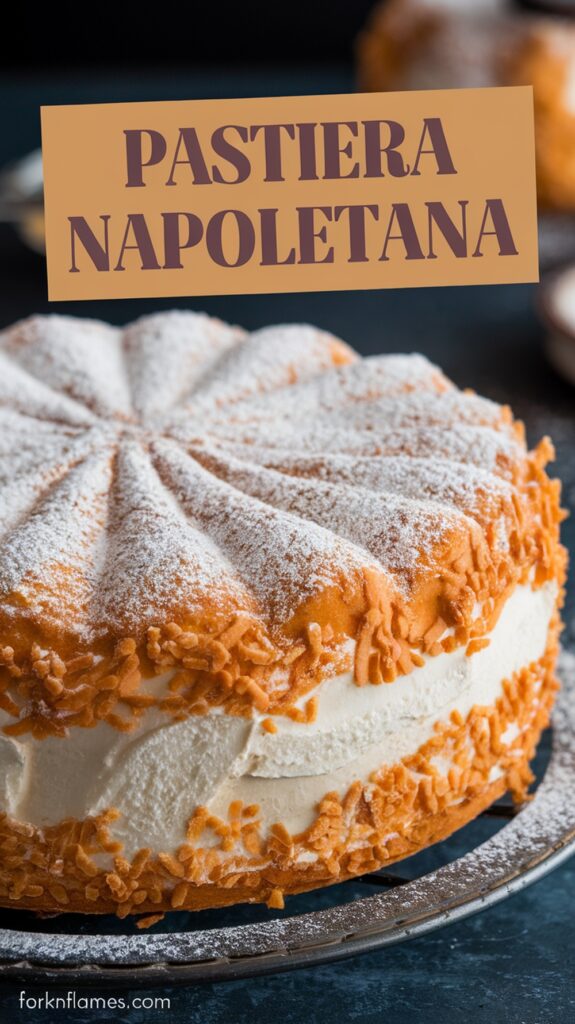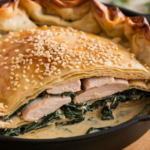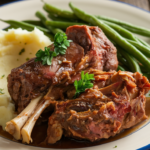Few desserts embody the essence of Naples quite like Pastiera Napoletana. This delightful ricotta and wheat pie, scented with orange blossom water, is a symbol of Easter in Southern Italy. Legend has it that the siren Parthenope, who enchanted sailors with her songs, created the pastiera as a gift to Naples, blending the finest local ingredients into a single, harmonious dish. Whether you believe the legend or not, one thing is certain—Pastiera Napoletana is a must-try delicacy that has been enjoyed for centuries.
The Origins of Pastiera Napoletana

Pastiera’s origins date back to ancient times when pagans celebrated the arrival of spring with grain-based desserts. Over the centuries, the dish evolved into the sweet tart we know today, perfected by Neapolitan convent nuns who refined its flavors. Traditionally baked on Holy Thursday or Good Friday, pastiera is left to rest until Easter Sunday, allowing its rich flavors to meld beautifully.
Now, let’s explore how to make this authentic Neapolitan masterpiece in your own kitchen.
Ingredients for Pastiera Napoletana
For the Shortcrust Pastry (Pasta Frolla):
- 300g (2 ½ cups) all-purpose flour
- 150g (⅔ cup) unsalted butter, cold and cubed
- 100g (½ cup) granulated sugar
- 1 whole egg + 1 egg yolk
- 1 tsp vanilla extract
- A pinch of salt
For the Wheat-Ricotta Filling:
- 200g (1 cup) cooked wheat (grano cotto, available in Italian markets)
- 100ml (½ cup) milk
- 30g (2 tbsp) unsalted butter
- 250g (1 cup) fresh ricotta cheese (preferably sheep’s milk)
- 200g (1 cup) granulated sugar
- 3 whole eggs + 1 egg yolk
- 50g (¼ cup) candied orange peel, finely chopped
- Zest of 1 lemon
- Zest of 1 orange
- 1 tbsp orange blossom water
- 1 tsp cinnamon (optional)
For Dusting:
- Powdered sugar
Step-by-Step Instructions

Step 1: Preparing the Shortcrust Pastry
- On a clean surface or in a large bowl, mix the flour, sugar, and salt.
- Add the cold butter and rub it into the flour with your fingertips until it resembles coarse crumbs.
- Create a well in the center and add the egg, egg yolk, and vanilla extract.
- Knead the mixture quickly until it forms a smooth dough. Wrap in plastic and refrigerate for at least 30 minutes.
Step 2: Cooking the Wheat Mixture
- In a small saucepan, combine the cooked wheat, milk, butter, and lemon zest.
- Cook over low heat, stirring frequently, until it becomes creamy (about 10 minutes).
- Remove from heat and let it cool completely.
Step 3: Making the Ricotta Filling
- In a large bowl, beat the ricotta and sugar until smooth and creamy.
- Add the eggs and egg yolk one at a time, mixing well after each addition.
- Stir in the candied orange peel, orange zest, orange blossom water, and cinnamon.
- Finally, fold in the cooled wheat mixture, ensuring an even consistency.
Step 4: Assembling the Pastiera
- Preheat the oven to 180°C (350°F).
- Roll out the shortcrust pastry to about 3mm (⅛ inch) thick and line a 9-inch tart pan, trimming the excess.
- Pour in the ricotta-wheat filling, smoothing the top.
- Roll out the remaining dough and cut into strips for a lattice top, arranging them in a crisscross pattern.
Step 5: Baking the Pastiera
- Bake for 50–60 minutes until golden brown and firm.
- Let it cool completely at room temperature, then refrigerate overnight for the flavors to develop fully.
Step 6: Serving
- Before serving, dust with powdered sugar.
- Slice and enjoy the fragrant, creamy delight with a cup of espresso!
Tips for the Perfect Pastiera Napoletana

- Plan ahead! Pastiera tastes best after resting for at least 24 hours, allowing its flavors to meld.
- Sheep’s milk ricotta is traditional, but cow’s milk ricotta works well too.
- Don’t skip the orange blossom water—it’s what gives pastiera its signature aroma!
- Use authentic grano cotto (pre-cooked wheat) for the best texture.
Why Pastiera Napoletana is a Symbol of Easter
Each ingredient in Pastiera holds deep symbolic meaning:
- Wheat represents rebirth and resurrection.
- Ricotta signifies purity and renewal.
- Eggs symbolize new life.
- Candied fruit adds festive sweetness, celebrating the joy of Easter.
Neapolitan families bake multiple pastiere at Easter, often sharing them with friends and neighbors, reinforcing the sense of community and tradition.
Final Thoughts
Making Pastiera Napoletana is more than just baking a pie—it’s a celebration of tradition, history, and the rich flavors of Naples. Whether you’re preparing it for Easter or simply indulging in a taste of Italy, this creamy, aromatic dessert is sure to become a favorite in your home.
So, why not try baking a Pastiera this year? You’ll be rewarded with an authentic slice of Neapolitan culture and a truly unforgettable dessert!

